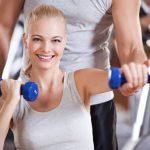When it comes to exercising and building strength, focusing on individual muscle groups is important. But have you ever wondered if there are specific muscle groups that work best together? In this article, we will explore the topic of what muscle groups to workout together, providing you with valuable insights and tips for optimizing your workouts.
Understanding how different muscle groups function is essential for creating an effective workout routine. By targeting specific muscles together, you can maximize your overall performance and see greater results in terms of strength gain, muscle tone, and aesthetics. However, it’s crucial to strike a balance between working out multiple muscle groups and avoiding overtraining or injury.
We will begin by breaking down the major muscle groups in the body and discussing their functions. This knowledge will provide a foundation for the rest of the article as we delve into various combinations of muscle groups for full-body workouts, upper body dominance, lower body empowerment, core stability, and isolation exercises.
By the end of this article, you’ll have a clear understanding of which muscle groups complement each other best during workouts. Whether your goal is to build strength, improve aesthetics, or enhance overall fitness, customizing your workout routine based on optimized muscle group pairings can significantly impact your progress. So let’s get started on exploring the world of muscle group combinations and discover the most effective ways to reach your fitness goals.
Understanding the basics
The success of any workout routine lies in understanding the basics of major muscle groups and their functions. By gaining this knowledge, individuals can optimize their workouts and achieve more effective results. Here is a breakdown of some major muscle groups and how they function:
Chest Muscles
The chest muscles, also known as pectoral muscles, consist of two main parts: the pectoralis major and pectoralis minor. These muscles are responsible for movements such as pushing, pressing, and hugging motions. Strengthening the chest muscles can improve upper body strength, posture, and overall aesthetics.
Back Muscles
The back muscles are divided into three main regions: the upper back (trapezius and rhomboids), the mid-back (latissimus dorsi or lats), and the lower back (erector spinae). Strong back muscles play a crucial role in maintaining good posture, providing stability to the spine, and assisting in various movements like pulling and rowing.
Shoulder Muscles
The shoulder muscles comprise several smaller muscle groups that work together to allow for a wide range of motion in the shoulders. This includes movements such as raising arms overhead, rotating shoulders externally or internally, and stabilizing the shoulder joints during activities. Strengthening these muscles can enhance shoulder flexibility, mobility, and overall upper body strength.
Arm Muscles
The arm muscles primarily include biceps brachii (located on the front of the upper arm) and triceps brachii (located on the back of the upper arm). These muscles contribute to arm flexion (biceps) and extension (triceps). Developing strong arm muscles not only enhances functional movements but also improves aesthetic appearance.
Leg Muscles
The leg muscles are divided into several groups, including the quadriceps (front of the thigh), hamstrings (back of the thigh), glutes (buttocks), and calf muscles. These muscles are responsible for various movements like walking, running, jumping, and squatting. Strengthening the leg muscles can improve lower body strength, stability, and overall athleticism.
Understanding the basic functions of major muscle groups allows individuals to structure their workouts effectively. By targeting specific muscle groups and understanding how they work together, individuals can create well-rounded workout routines that address their fitness goals and personal preferences. Whether it’s targeting upper body strength, lower body empowerment, or core stability, optimizing muscle group combinations is key to achieving optimal results.
Full body workouts
Full body workouts are a popular choice among fitness enthusiasts due to their efficiency and ability to target multiple muscle groups in a single session. By incorporating exercises that engage various muscle groups, individuals can maximize their time at the gym and achieve well-rounded development. In this section, we will explore the advantages of full body workouts, as well as some considerations when combining multiple muscle groups in a single workout session.
Advantages of Full Body Workouts
One of the biggest advantages of full body workouts is their ability to provide a comprehensive and balanced approach to training. By engaging multiple muscle groups in each workout, individuals can ensure that no major muscle group is neglected, promoting overall functional strength and stability.
Additionally, full body workouts tend to burn more calories compared to isolated exercises since they utilize larger muscle groups and require more energy expenditure. This makes them an excellent choice for those looking to lose weight or improve overall cardiovascular fitness.
Another advantage of full body workouts is their time-saving aspect. Rather than spending hours at the gym splitting up your routine into specific muscle group days, you can effectively target all major muscles in just one session. For individuals with busy schedules or limited time for exercise, this can be a game-changer.
Considerations for Combining Multiple Muscle Groups
While full body workouts offer many benefits, it’s important to consider several factors when combining multiple muscle groups in a single workout session. Firstly, it’s crucial to prioritize compound exercises that engage multiple joints and muscle groups simultaneously. Exercises such as squats, deadlifts, bench presses, and pull-ups are excellent examples of compound movements that work multiple muscles at once.
Additionally, it’s important to ensure adequate rest and recovery between sets and sessions. Since each exercise targets different muscles within the same workout, giving yourself enough rest time allows your muscles to recover before targeting them again with another exercise. This helps prevent overtraining and reduces the risk of injury.
Lastly, be mindful of your own fitness level and capabilities. If you are a beginner, it’s recommended to start with lighter weights and focus on mastering proper form before progressing to more advanced exercises or heavier loads. Gradually increase the intensity and complexity of your workouts as your strength and technique improve.
Overall, full body workouts provide numerous advantages for individuals seeking a well-rounded training approach. By combining multiple muscle groups in a single workout session, individuals can save time, maximize calorie burn, and achieve balanced development. However, it’s important to consider factors such as exercise selection, rest periods, and individual fitness levels to optimize the effectiveness of these workouts.
Upper body dominance
When it comes to achieving upper body strength and aesthetics, combining specific muscle groups in your workout routine can be highly effective. Not only does it allow you to target multiple muscle groups in one session, but it also maximizes the efficiency of your workouts. Here are some benefits and recommended muscle group pairings for those looking to dominate their upper body workouts.
- Chest and triceps: Combining chest exercises like bench press or push-ups with tricep-focused exercises such as tricep dips or overhead extensions can help you develop a well-rounded upper body. These muscle groups often work together during pushing movements, so pairing them together can enhance their overall development.
- Back and biceps: The back muscles, including the latissimus dorsi (lats) and other supporting muscles, play a vital role in pulling movements. Pairing them with bicep exercises like rows or curls allows for a synergistic effect, helping you develop a balanced upper body strength.
- Shoulders: The shoulder muscles consist of three main heads – anterior (front), medial (middle), and posterior (rear). It is important to target all three heads for a well-rounded shoulder development. Pairing shoulder presses or lateral raises with exercises that target the rear delts, such as face pulls or bent-over lateral raises, ensures you address all areas of the shoulder for optimal aesthetics.
It’s worth noting that while pairing muscle groups together in one workout session is beneficial, it’s important to give each muscle group adequate rest between sessions. Overtraining can lead to decreased performance and increased risk of injury. Therefore, consider incorporating at least one day of rest or working different muscle groups on consecutive days while allowing ample recovery time.
Lower body empowerment
When it comes to lower body workouts, targeting the key muscle groups is essential for building strength and achieving a well-rounded physique. The glutes, hamstrings, quads, and calves are all important muscles that work together to provide stability and power during various movements. By combining these muscle groups in your workouts, you can maximize their potential and see greater results.
One effective combination for lower body workouts is pairing exercises that target the glutes and hamstrings. These muscles often work in synergy during movements such as squats, deadlifts, lunges, and hip thrusts. By incorporating exercises like Romanian deadlifts or glute bridges into your routine along with squats or lunges, you can effectively engage both the glutes and hamstrings while also targeting other muscle groups in the legs.
Another valuable combination of muscle groups for lower body workouts is focusing on the quadriceps (quads) and calves. The quads are responsible for knee extension and play a major role in movements like leg presses or step-ups. Pairing these exercises with calf raises or jump squats can help engage both the quads and calves simultaneously. This combination not only strengthens the legs but also improves overall explosiveness and athleticism.
In order to track your progress when incorporating these combinations into your workout routine, consider using a progression log to keep track of weights lifted or sets completed per exercise. This will allow you to gradually increase weight or volume over time, promoting continuous improvement and muscle growth.
| Muscle Group | Exercise Examples |
|---|---|
| Glutes & Hamstrings | Romanian deadlifts, glute bridges paired with squats or lunges |
| Quads & Calves | Leg presses, step-ups paired with calf raises or jump squats |
Incorporating these effective combinations into your lower body workouts will not only help you target specific muscle groups but also promote overall strength and balance in your lower body. Remember to consult with a fitness professional before starting any new workout routine to ensure proper form and technique.
Core stability and functionality
Core stability and functionality are crucial for overall strength and performance in any fitness routine. The core muscles play a vital role in providing stability and support for the rest of the body, improving posture, preventing injuries, and enhancing athletic performance. When it comes to developing a strong and stable core, there are key muscle groups that should be focused on, including abs, obliques, and lower back muscles.
- Abs: The abdominal muscles, specifically the rectus abdominis (six-pack muscles) and the transverse abdominis (deep core stabilizer), are responsible for flexing the spine and supporting it during various movements. Exercises like crunches, planks, leg raises, and Russian twists can target these muscle groups effectively.
- Obliques: The obliques are located on the sides of the abdomen and play a crucial role in rotational movements of the torso. Strengthening these muscles can improve functional movements such as twisting, turning, and bending. Side plank variations, bicycle crunches, and woodchops are great exercises to target the obliques.
- Lower back muscles: Strong lower back muscles provide stability to the spine and help maintain proper posture. They also play a significant role in various compound lifts like deadlifts or squats. Exercises like supermans, bird dogs, hyperextensions can effectively target and strengthen the lower back muscles.
It’s important to note that core training should not focus solely on building six-pack abs but should also prioritize developing overall core strength and stability. Incorporating exercises that target all three muscle groups – abs, obliques, and lower back – will contribute to a well-rounded core workout routine.
Including these exercises in your regular workout routine can lead to improved functional movement patterns, reduced risk of injury while performing daily activities or sports-related movements. Additionally, having a strong core is beneficial for better balance and stability during strength training exercises.
Remember to always maintain proper form while performing core exercises and gradually increase the intensity and difficulty as you progress. It’s also important to listen to your body and consult with a fitness professional if you have any underlying conditions or injuries.
By targeting the key muscle groups mentioned above, individuals can develop a strong and stable core that will benefit them in all areas of their fitness journey. Whether your goal is improved athletic performance, enhanced posture, or injury prevention, incorporating core-focused exercises into your routine can make a significant difference.
Isolating muscle groups
Isolating muscle groups is an essential component of any effective workout routine, as it allows for improved muscle hypertrophy and balanced development. By focusing on specific muscle groups during your workouts, you can target and stimulate them more efficiently, leading to greater strength gains and aesthetic improvements. In this section, we will explore the importance of isolating muscle groups and provide some tips on how to effectively target specific muscles for maximum results.
The Benefits of Isolating Muscle Groups
When you isolate a specific muscle group during your workout, you are able to place a greater emphasis on that particular muscle. This targeted approach helps to create greater tension within the muscle fibers, resulting in increased muscle fiber recruitment and stimulation. The more you can activate a particular muscle group, the more potential there is for muscular growth and strength gains.
By focusing on specific muscle groups, you can also address any imbalances or weaknesses in your physique. For example, if you notice that your chest muscles are weaker compared to your back muscles, you can prioritize chest exercises during your workouts to bring about a more balanced development.
Tips for Targeting Specific Muscles
One effective way to isolate a specific muscle group is by performing exercises that primarily target that particular muscle. For example, if you want to focus on your biceps, exercises such as bicep curls or hammer curls would be ideal choices. Be sure to use proper form and technique to ensure that the targeted muscles are doing the majority of the work.
Another strategy is incorporating isolation exercises at the end of your workout session after completing compound exercises. Compound exercises involve multiple muscle groups working together whereas isolation exercises focus on one specific muscle group. By starting with compound movements like squats or bench presses before moving on to isolation exercises like leg extensions or tricep pushdowns, you can ensure that the larger muscles are adequately fatigued before targeting smaller muscles.
It is important to note that while isolating muscle groups is beneficial, it should not be the sole focus of your workouts. A well-rounded routine that includes compound exercises, cardiovascular training, and flexibility work is essential for overall fitness and functionality. Remember to listen to your body, vary your exercises, and consult with a fitness professional if needed to ensure you are progressing safely and effectively in your journey towards improved muscle hypertrophy and balanced development.
Customizing your workout routine
Personal Fitness Goals
When customizing your workout routine and deciding which muscle groups to pair together, it is important to consider your personal fitness goals. Different combinations of muscle groups can target specific areas of the body or achieve different training objectives.
For example, if your goal is to build strength and size in your upper body, you may want to focus on pairing muscle groups such as chest and triceps, back and biceps, or shoulders and arms. On the other hand, if you are looking to improve overall endurance and cardiovascular health, you may opt for full body workouts that incorporate multiple muscle groups simultaneously.
Fitness Level
Your current fitness level should also be taken into consideration when determining which muscle groups to pair together. If you are a beginner or have limited experience with strength training, it may be beneficial to start with full body workouts or focus on larger muscle groups before progressing to more isolated exercises.
This will allow you to build a solid foundation of strength and ensure balanced development across all major muscle groups. As you become more experienced and advanced in your training, you can then target specific muscles with greater intensity and volume.
Training Preferences
Lastly, it is essential to consider your training preferences when customizing your workout routine. Some individuals may prefer focusing on one or two major muscle groups per session for maximum intensity and fatigue, while others may enjoy full body workouts that provide a well-rounded training stimulus.
Additionally, personal preferences for exercise selection (e.g., compound movements vs isolation exercises) can influence which muscle groups are paired together. It is important to choose combinations that align with your preferences so that you can maintain consistency and enjoyment in your workouts.
By considering these factors – personal fitness goals, fitness level, and training preferences – when deciding which muscle groups to pair together in your workout routine, you can create a program that is tailored to your individual needs and objectives. Remember, there is no one-size-fits-all approach when it comes to optimizing muscle groups during workouts, so it is essential to find the combinations and strategies that work best for you.
Experimentation, feedback from experts, and self-reflection will ultimately help you maximize your results and achieve your desired fitness outcomes.
YEG Fitness perspective
As mentioned in the previous sections, optimizing muscle group pairings during workouts is crucial for achieving desired fitness goals. In this section, we will delve into the YEG Fitness perspective and provide insights from top fitness experts and trainers in the YEG region on optimal muscle group pairings for effective workouts.
When it comes to full body workouts, our experts emphasize the importance of combining major muscle groups to maximize efficiency and engage multiple areas of the body. One recommended pairing is combining chest and back exercises for a balanced upper body workout. This combination not only targets the major muscles in these areas but also promotes overall upper body strength and aesthetics.
For lower body empowerment, our experts suggest targeting glutes, hamstrings, quads, and calves in a single workout session. Combining exercises such as squats, lunges, deadlifts, and calf raises help to target all these muscle groups effectively. This approach allows for comprehensive lower body development while also improving overall lower body strength and stability.
In terms of core stability and functionality, our fitness experts emphasize focusing on abs, obliques, and lower back muscles. These muscle groups play a vital role in providing strength and stability throughout various movements. By incorporating exercises like planks, Russian twists, and supermans into your routine, you can strengthen your core muscles effectively.
| Muscle Group Pairing | Recommended Exercises |
|---|---|
| Chest & Back | Push-ups / Bench press (chest), Pull-ups / Rows (back) |
| Glutes, Hamstrings, Quads & Calves | Squats / Lunges (glutes, hamstrings, quads), Calf raises (calves) |
| Abs, Obliques & Lower Back | Planks / Russian twists (abs, obliques), Supermans / Deadbugs (lower back) |
Remember, these are just general recommendations. It is essential to customize your workout routine based on individual fitness goals, fitness level, and training preferences. Consulting a fitness professional can help you tailor the exercises and muscle group pairings to suit your specific needs.
In the next section, we will address frequently asked questions about muscle group combinations, providing additional tips and addressing concerns that readers may have. Stay tuned for more valuable insights.
Frequently asked questions
As individuals strive to optimize their workouts and achieve their fitness goals, they often have questions about the most effective ways to pair muscle groups during exercise. Here, we will address some common inquiries and provide helpful tips for readers:
- Should I always work out multiple muscle groups together?
- What are some examples of complementary muscle group pairings?
- How can I ensure balanced development when isolating specific muscle groups?
While combining multiple muscle groups in a single workout session can be beneficial, it is not always necessary. It depends on your specific goals and what you enjoy doing. Some individuals prefer working out specific muscle groups on separate days to focus on each one more intensely. Others find that full body workouts or pairing complementary muscle groups together yield better results.
Pairing complementary muscle groups can help maximize efficiency during workouts. For instance, when targeting the upper body, combining exercises for chest and triceps or back and biceps can create a balanced workout routine. Similarly, for the lower body, pairing exercises for quads and hamstrings or glutes and calves is effective.
Isolating specific muscle groups is important for targeting particular areas of the body and achieving balanced development. To ensure this, it is recommended to incorporate compound movements into your routine. Compound exercises involve multiple joints and engage several muscles simultaneously, promoting overall strength while still emphasizing targeted areas.
| Question | Answer |
|---|---|
| Should I always work out multiple muscle groups together? | While combining multiple muscle groups in a single workout session can be beneficial, it is not always necessary. |
| What are some examples of complementary muscle group pairings? | For the upper body, chest and triceps or back and biceps can be paired. For the lower body, quads and hamstrings or glutes and calves are effective combinations. |
| How can I ensure balanced development when isolating specific muscle groups? | Incorporate compound movements into your routine to engage multiple muscles simultaneously and promote overall strength while still targeting specific areas. |
By addressing these common inquiries, readers will gain a better understanding of how to optimize their workouts by pairing muscle groups effectively. Remember, there is no one-size-fits-all approach, so it’s essential to consider your personal fitness goals, fitness level, and preferences when customizing your workout routine.
Conclusion
In conclusion, understanding the importance of optimizing muscle groups during workouts is essential for achieving effective results. By targeting specific muscle groups and combining them strategically in our workout routines, we can maximize strength, aesthetics, and overall fitness.
From the breakdown of major muscle groups and their functions to the advantages of full body workouts, this article has provided a comprehensive guide on how to pair different muscle groups together. Whether it’s focusing on upper body dominance for improved strength or targeting the lower body for glute and leg empowerment, there are various combinations that can be explored based on individual goals and preferences.
Additionally, the article emphasizes the significance of core stability and functionality, as well as isolating muscle groups for hypertrophy and balanced development. This knowledge allows readers to customize their workout routines according to their fitness level, personal goals, and training preferences.
Overall, incorporating the insights shared by top fitness experts in the YEG region into our workout routines can greatly enhance our results. By applying this knowledge and experimenting with different muscle group pairings, readers can achieve optimal outcomes while also addressing common concerns and FAQs related to muscle group combinations.
It’s time to take action. Armed with this newfound understanding of muscle group pairings, it is now up to each reader to implement these strategies into their own workouts. Remember that consistency and adapting your routine over time are key to seeing progress. So go ahead, experiment with different combinations, listen to your body’s needs, and watch as your fitness journey reaches new heights.

Passionate about providing useful information to anyone with an interest in the field of Personal Training, I strive to pass on to our readers quality information and to answer any questions about Personal Trainers, the work they do and how to become one.





